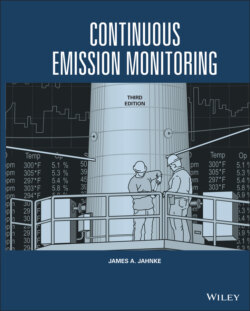Читать книгу Continuous Emission Monitoring - James A. Jahnke - Страница 127
Bouguer's Law
ОглавлениеParticle scattering and absorption effects can be treated in a manner similar to that in the previous discussion on light absorption by gas molecules. Similar to the Beer–Lambert law, Bouguer's law is used when discussing particle scattering. Bouguer's law states that transmittance decreases exponentially by the product naQL, as shown in Equation 4‐8.
(4‐8)
where n = number concentration of the particles
a = projected area of the particles
Q = particle extinction coefficient
L = length of the light path through the flue gas
The expression was first stated by P. Bouguer in 1760 and later rediscovered by Lambert. In deference to the earlier work of Bouguer, it has become customary in the field of opacity monitoring to call it Bouguer's law (Middleton 1968).
Q is the particle extinction coefficient, which is dependent on the wavelength and expresses how the particle of size a scatters and absorbs light of wavelength λ. It is analogous to the absorption cross section σ(λ), discussed previously. Theoretically, it should be possible to calculate the opacity from first principles using Equation 4‐8. Because there are usually particles with more than one size in a flue gas, the particle size distribution and the Mie scattering coefficients need to be determined for each size particle. The data demands and calculation difficulties make this approach impractical although attempts have been made in the past (Ensor and Pilat 1971; Pilat and Ensor 1970; Thielke and Pilat 1978). Equation 4‐8 is overly simplified, being expressed for particles of only one size (see Jahnke (1984) for more detailed expressions).
Bouguer's law is an exponential relationship between transmittance and particulate matter concentration and is somewhat difficult to use in stack emission calculations. Another expression, called “optical density,” is used in opacity monitor specifications and calculations. It is related to opacity as follows:
(4‐9)
Optical density is useful in emission calculations because it is directly proportional to the particulate concentration, as shown in the following derivation.
First, taking the natural logarithm of both sides of Equation 4‐8 gives
(4‐10)
and rearranging gives
and therefore
(4‐11)
The expression can be written in terms of particulate concentration c, instead of the particle number density n:
(4‐12)
where
AE = πr2Q/m, the specific mass extinction coefficient
r = particle radius
m = particle mass
c = particle concentration
This expression merely states that optical density is directly proportional to the particulate matter concentration and also to the pathlength. It is a very useful relation, because if, for example, the pathlength should increase by a factor of 2, the optical density will increase by the same factor. If the particulate matter concentration is decreased by 1/2, D also decreases by 1/2. Applications of this expression are examined in Chapter 8 on opacity monitors.
